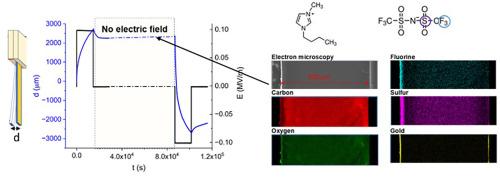Remanent deformation and local stiffening induced by electric field in low glass transition epoxy-amine polymer network doped with ionic liquid
IF 4.5
2区 化学
Q2 POLYMER SCIENCE
引用次数: 0
Abstract
Room temperature ionic liquids (RTILs) can behave like solids as the result of their ordering in the vicinity of substrates or confining in porous membranes. In this work, we have used this specific property to fabricate soft electroactuators in which deformation can be maintained after removal of the electric field. Epoxy-amine doped with 5%wt of 1-butyl-3-methylimidazolium bis(trifluoromethylsulfonyl)imide (BMIM TFSI) was processed. The study of bending under a constant electric field of E=0.1 MV/m shows slow deformation kinetics as a function of time. Interestingly, when the electric field is removed, around 80% of the displacement is maintained for at least a day. The reversibility of this phenomenon was checked by successively applying positive and negative electric fields. It shows that complex successive electro-mechanical cycles can be performed without performance degradation (i.e. the sample reaches the same bending amplitude). Besides, energy dispersive X-ray spectroscopy was used to map the bis(trifluoromethylsulfonyl)imide counter anion before and after the application of the electric field and revealed the presence of a persistent anionic rich layer near the positive electrode after removing the electric field. This result was also supported by atomic force microscopy, which revealed an improvement in sample stiffness near the positive electrode. It explains the observed remanent deformation and opens up prospects for the processing of materials whose stiffness can be controlled by applying an electric field.

离子液体掺杂低玻璃化过渡环氧胺聚合物网络中电场诱导的残余变形和局部硬化
室温离子液体(RTILs)可以表现得像固体一样,因为它们在衬底附近有序或被限制在多孔膜中。在这项工作中,我们利用这一特性制造了软电致动器,其中在去除电场后可以保持变形。环氧胺掺杂5%wt的1-丁基-3-甲基咪唑双(三氟甲基磺酰基)亚胺(BMIM TFSI)。在恒定电场E=0.1 MV/m下的弯曲研究表明,变形动力学随时间的变化缓慢。有趣的是,当电场被移除时,大约80%的位移可以维持至少一天。这种现象的可逆性是通过先后施加正负电场来检验的。这表明,复杂的连续机电循环可以在不降低性能的情况下进行(即样品达到相同的弯曲幅度)。此外,利用能量色散x射线光谱对施加电场前后的双(三氟甲基磺酰)亚胺反阴离子进行了映射,发现去除电场后正极附近存在一个持久的富阴离子层。原子力显微镜也支持这一结果,显示了正极附近样品刚度的改善。它解释了观察到的残余变形,并为可以通过施加电场控制刚度的材料的加工开辟了前景。
本文章由计算机程序翻译,如有差异,请以英文原文为准。
求助全文
约1分钟内获得全文
求助全文
来源期刊

Polymer
化学-高分子科学
CiteScore
7.90
自引率
8.70%
发文量
959
审稿时长
32 days
期刊介绍:
Polymer is an interdisciplinary journal dedicated to publishing innovative and significant advances in Polymer Physics, Chemistry and Technology. We welcome submissions on polymer hybrids, nanocomposites, characterisation and self-assembly. Polymer also publishes work on the technological application of polymers in energy and optoelectronics.
The main scope is covered but not limited to the following core areas:
Polymer Materials
Nanocomposites and hybrid nanomaterials
Polymer blends, films, fibres, networks and porous materials
Physical Characterization
Characterisation, modelling and simulation* of molecular and materials properties in bulk, solution, and thin films
Polymer Engineering
Advanced multiscale processing methods
Polymer Synthesis, Modification and Self-assembly
Including designer polymer architectures, mechanisms and kinetics, and supramolecular polymerization
Technological Applications
Polymers for energy generation and storage
Polymer membranes for separation technology
Polymers for opto- and microelectronics.
 求助内容:
求助内容: 应助结果提醒方式:
应助结果提醒方式:


